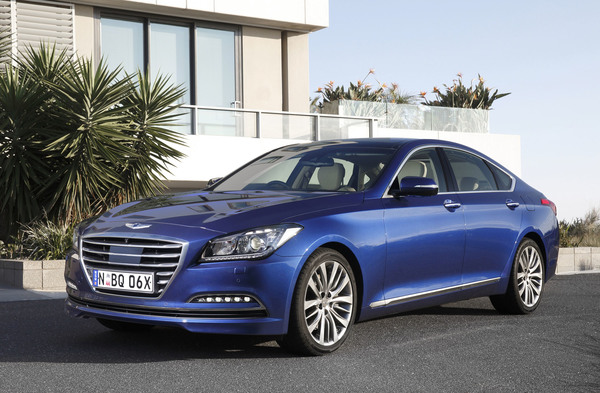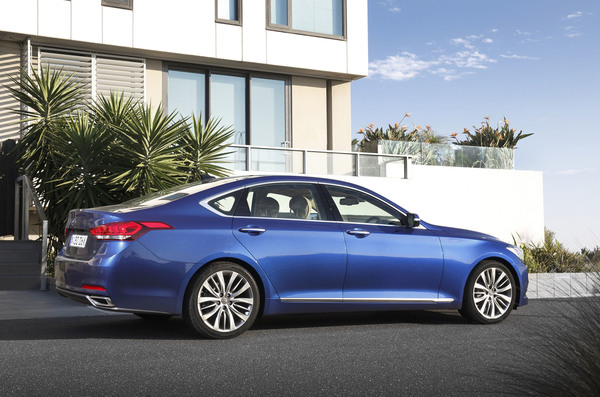By DEREK OGDEN
The Hyundai Genesis: it’s hard to know where to start.
The luxury sedan from South Korea was benchmarked against BMW, Mercedes-Benz, Audi, Lexus and Jaguar.
In Australia it even competes with top end Australian models from Holden and Ford, as well as the Chrysler 300 from the US.
Hyundai’s flagship delivers eye-watering high levels of automotive technology and refinement at astonishingly low prices.
The first-generation left-hand-drive only BH Genesis set the standard with rave reviews and major awards, including the 2009 North American Car of the Year, now the all-new second-generation DH model eclipses this in many ways.
The unfortunately tagged ‘DH’ underwent high-speed and durability testing on the famed Nordschleife Nurburgring in Germany and at Yeongam Circuit, Korea.
It also did some extreme hot-weather testing in Death Valley in the USA and cold-weather testing on Sweden’s Argeplog Lake.
That wasn’t the end, our local engineers oversaw final durability testing in eastern and central Australia.
The basic Genesis is bursting at the seams with innovative high-tech kit, some of which is an expensive addition in European rivals, and others not at all, yet it comes to Australia market for a mere $60,000.
This can be topped up with more features from two packs, Sensory and Ultimate, for $71,000 and $82,000 respectively. Hyundai took the middle ground with our road test vehicle, the Genesis Sensory Pack.
Genesis has a one-piece hexagonal grille, HID headlights, LED indicators and daytime running lights, a sweeping line along its flanks, aerodynamic boot lid, and ‘jewelled’ LED tail-lights.
At 4990mm, the Genesis is 91mm longer than a BMW 5 Series and 43mm longer than a Holden Commodore and its width of 1890mm is 30mm wider than a 5 Series and only 8mm narrower than a Commodore.
Genesis, with its Sonata stablemate, last year earned Good Design Awards for quality design, function and aesthetics from The Chicago Athenaeum, the Museum of Architecture and Design, and The European Centre for Architecture Art Design and Urban Studies.
The wheelbase of 3010mm is not only longer than that of a BMW 5 Series but also 1mm longer than the wheelbase of a Holden Caprice and translates to a generous amount of space for occupants.
It’s a premium look all round with widespread use of soft-touch materials, timber-style trim surrounds and real aluminium detail, while double-stitched, perforated leather-appointed front seats offer 12-way adjustment for the driver.
The test vehicle’s Sensory Pack has an extendable seat-cushion for under-thigh support, bolster adjustment and four-way lumbar-support adjustability.
Attention to detail is characterised by a new dash top designed to decrease reflections in the windscreen.
The stylish centre console features a square clock that’s synchronised via satellite.
An impressive 9.2-inch wide-view touchscreen is centrally located on the dash.
It gives offers access to satellite navigation incorporating Here maps, Suna live traffic updates, and a comprehensive Point of Interest database.
Also included is Here MapCare where up to three years free mapping updates are provided when the vehicle is serviced at a participating Hyundai dealer.
The touchscreen also acts as a display for the Genesis around-view monitor, providing a 360-degree bird’s-eye view of the vehicle.
In amazing attention to detail, the Grammy Lexicon sound system utilises 17 speakers uses an algorithm program to the car’s interior contours and trim materials.
Genesis sedans are powered by Hyundai’s 3.8-litre V6 engine, driving the rear wheels through an in-house eight-speed automatic transmission.
The motor produces 232 kW maximum power at 6000 rpm and 397 Nm maximum torque at 5000 rpm, with 90 per cent of the latter available between 2000rpm and 6000rpm.
The Lambda II uses Gasoline Direct Injection, triangular-pattern fuel injectors, Dual Continuously Variable Valve Timing, three-stage variable induction, all-aluminium block and heads, steel timing chain and iridium-tipped spark plugs.
Hyundai Genesis was awarded the highest ever ANCAP score achieved in local crash testing.
Passive safety equipment includes nine airbags, pre-tensioner seatbelts and anti-whiplash head restraints.
Active safety features are smart cruise control, autonomous emergency braking, blind-spot detection, lane change assist, lane departure warning, rear cross traffic alert and smart high beam.
There has been great attention given to in-cabin noise, vibration and harshness suppression with extensive use of sound-deadening measures.
On the other hand, Hyundai engineers worked to enhance agreeable sounds.
Under acceleration, for example, dynamic engine sound improvements were achieved through intake and exhaust system tuning.
No artificial sound generation techniques are used.
The 3.8-litre high-tech V6 engine has impressive performance off the mark (zero-to-100 km/h acceleration is a claimed 6.5 seconds).
Combined fuel consumption is listed as 11.2 litres per 100 kilometres.
However, the V6 motor gulped 14 to 16 litres per 100 kilometres in the city.
That was balanced by seven to nine litres on the open road.
Exclusive to the Genesis, the Hyundai-developed eight-speed automatic has beautifully smooth gear shifts.
The switch to Shiftronic manual with steering-wheel-mounted paddles, provided a certain degree of satisfaction when not shackled by local driving restrictions.
The Hyundai range is available for test drive at Berwick Hyundai, 34 Kangan Drive, Berwick. Phone 9707 1212.
Model range
Genesis 3.8L GDi V6 8sp automatic: $60,000
Genesis 3.8L GDi V6 8sp automatic: Sensory Pack $71,000
Genesis 3.8L GDi V6 8sp automatic: Ultimate Pack $82,000









